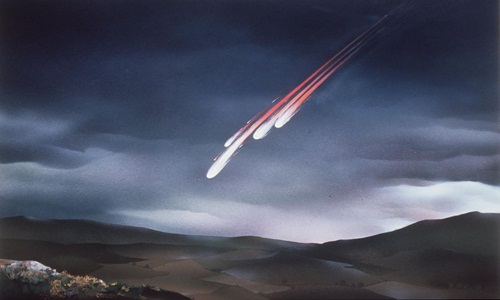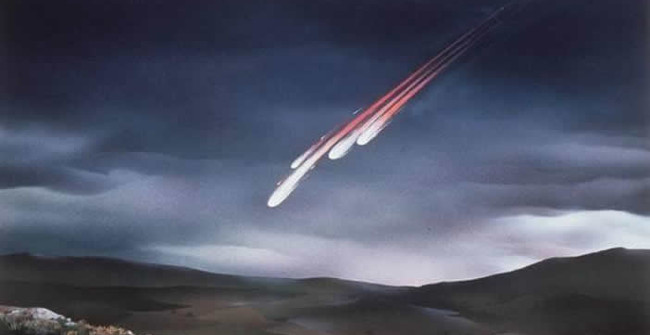Disaster on Earth when the Sun is obscured for many years
Some events that have occurred on Earth significantly block sunlight for a long time, seriously affecting living organisms.
Collision with asteroids

Large asteroids colliding with the Earth can push many materials into the air, blocking sunlight.(Photo: Sun.)
About 65 million years ago, the Creta mass extinction event - the Third High (K-T), erased 80% of the species that live on Earth, according to Live Science. Many scientists believe that this event was caused by a giant comet or meteorite colliding with the Earth, creating a 180-km-wide crater on the Yucatan Peninsula, Mexico.
"Fragments and dust from the collision are blown to the upper atmosphere, quickly covering the Earth or at least one hemisphere. This prevents sunlight from reaching the ground , " said Linda Ivany. , ancient climate specialist at Syracuse University, USA, said.
In addition, the large amount of heat generated from the collision burned many forests and other vegetation, dispersing more ash into the atmosphere."The ash particles can survive for a long time in the atmosphere, years after the event , " Ivany said.
Dust ash does not completely block sunlight like a total solar eclipse but only reduces the intensity of light, but it is also enough to kill living plants through photosynthesis and animals eat them.
"Sunlight energy has been declining for months or years, hurting the ability of the organism to grow and reproduce , " Ivany said.
Volcanic ash

Volcanic volcanic eruptions can create a lot of ash to cover the sky.(Photo: iStock.)
The impact of asteroids is not the only event capable of blocking sunlight. Volcanoes can also "obscure" the sky on a global scale.
On April 5, 1815, the Tambora volcano in Indonesia erupted, releasing 150 km3 of rock and ash to a height of 29 km. This is the most powerful volcanic eruption in modern history. Immediately after the volcano erupted, the ash cloud gradually expanded to cover an area approximately equal to Australia. The air temperature in the area drops to 11 degrees Celsius, according to Scientific American.
Volcanic ash exists in the atmosphere for a long time, then spreads throughout the Earth. BBC said the dust cloud from Tambora volcano caused global temperatures to drop from 0.4 to 0.7 degrees C. A year later, many areas in Europe and North America had no summer. Frost destroys crops in Canada and New England, USA.
- Recreating the meteorite disaster 66 million years ago made the dinosaurs extinct
- Using an ultra-high-speed camera captures the obscured object
- Two years in the darkness of the Earth after the asteroid disaster
- Evidence of comets hitting the Earth, sweeping away life 13,000 years ago
- The disaster of 13,000 years ago predicted that the Earth was about to be destroyed?
- Most creatures on Earth disappeared 2 billion years ago
- Comet 26km wide can destroy the Earth in 4479
- Giant meteorite approached the Earth at midnight on September 7
- Suffering from meteorite disaster but why dinosaurs are extinct, birds are not?
- Disaster disaster
- When the Earth warms up by 2 degrees, how horrible does the disaster happen?
- 'Great extinction' used to happen on Earth
 'Fine laughs' - Scary and painful torture in ancient times
'Fine laughs' - Scary and painful torture in ancient times The sequence of numbers 142857 of the Egyptian pyramids is known as the strangest number in the world - Why?
The sequence of numbers 142857 of the Egyptian pyramids is known as the strangest number in the world - Why? History of the iron
History of the iron What is alum?
What is alum?